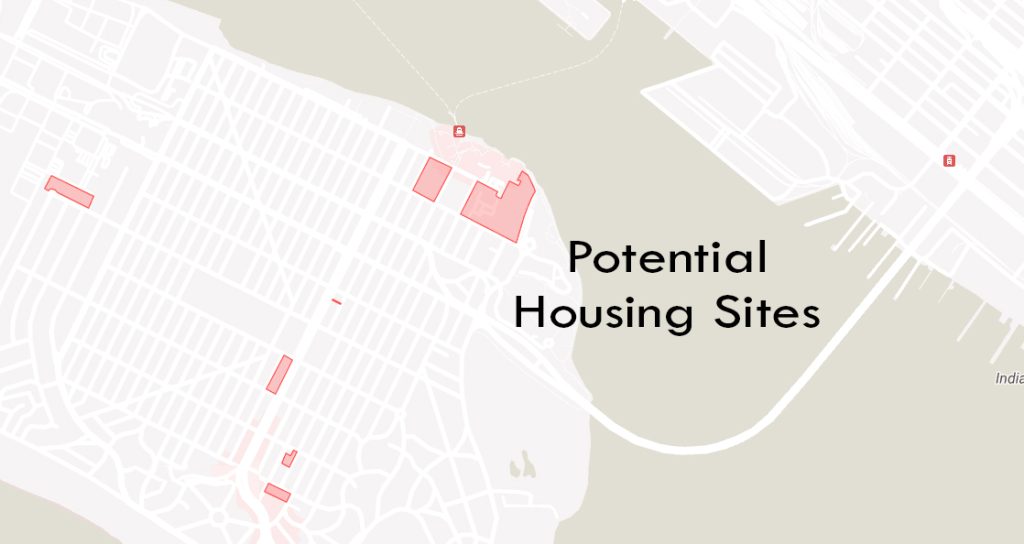The Coronado Planning Commission unanimously rejected the city’s updated Housing Element plan in a symbolic vote of disapproval of the 912 additional housing units the city was allocated.
“We’re so handcuffed in this, in my mind, we can vote against this at least in principle,” said Commission Chair Ed Weisbrod at the commission’s March 26 meeting.
The plan is still expected to be approved by the City Council – but only because the state will intervene if the city does not pass a compliant housing element that rezones for 912 additional housing units.
Earlier this year, the state enacted a moratorium on building permits in the city of Beverly Hills after it failed to pass a housing element approved by the California Department of Housing and Community Development (HCD).
Other ramifications could include fees of up to $100,000 per month, lack of access to state funding, and or rescinding a city’s zoning ability.
A chief concern is the builder’s remedy, a provision in the 1990 Housing Accountability Act that allows developers to bypass a city’s zoning and general plan if that city is out of compliance with the HCD.
Theoretically, if the city did not pass a compliant housing element, developers could build much taller buildings on their land than what the city is rezoning for.
For example, one widely contested opportunity site in the housing element plan zones for a four-story, 116-unit building at the site that includes a Smart & Final Extra! A developer including affordable housing at this site would qualify for the state’s 50% parking reduction incentive. City leaders say that by rezoning in compliance with HCD terms, it maintains some control and prevents even broader development.
Commissioner Scott Metzger initially argued for approving the plan, since the City Council likely will do so as well.
“I don’t like this at all; I don’t like one thing about it,” he said. “But the ramifications of denying this is even more a loss of control than we have now.”
Commissioner Peter Jensen said a symbolic vote to deny the housing element would add to the record of the city’s disapproval of its housing allocation. The motion to deny passed unanimously. Commissioners Dana Cavanaugh and Jon Ryan were absent from the meeting.
Coronado and several other small cities filed a lawsuit after receiving its housing allocation, saying the San Diego Association of Governments gave in a controversial weighted vote. The city lost, and then lost an appeal. The city brought its case to the California Supreme Court, which opted against hearing the case.
In January 2023, the HCD warned the city that it must comply with its housing element allocation or face legal action.
The city ultimately unveiled a plan in October 2023 that rezones for 912 units of new housing (plus a 15 percent buffer). City Council approved the plan, saying it had little choice in the matter, but counted as a win the fact that the state agreed to let planned U.S. Navy housing count toward its allocation, which had never before been allowed.
The city is obligated to zone for new housing, but the decision to develop rezoned parcels falls on property owners. Owners are also not obligated to include any affordable housing units if they do develop. Although the state offers incentives for affordable housing, developers could opt to only build market-rate units.

“This city has done everything to fight this for years, spent a lot of money fighting it, and got nowhere,” Metzger said. “The staff has worked very hard to create the best of a very bad situation which I don’t like at all, but I don’t see that we have a choice as residents of the state of California. I think the remedy is at the ballot box: Get new state legislators.”
Because only three commissioners were present, a unanimous vote was required. Metzger ceded and voted to reject the housing element plan. It is slated to come before the Coronado City Council on April 16.
The exclusion of small lots as opportunity sites
During public comment, residents predictably decried the housing element, but many acknowledged that the city had little control over it.
Several property owners questioned why their parcels were not considered as opportunity sites for development. Amy Melden, a property owner and 20-year Coronado resident, said she tried unsuccessfully to get the city to include her parcel as an opportunity site.
 The HCD stipulates that, in general, lots must be at least half an acre in size to be considered an opportunity site. One site in Coronado’s housing element plan – 517 Orange Ave. – is smaller than that, but was excepted from the policy because it is owned by the city.
The HCD stipulates that, in general, lots must be at least half an acre in size to be considered an opportunity site. One site in Coronado’s housing element plan – 517 Orange Ave. – is smaller than that, but was excepted from the policy because it is owned by the city.
“Most of the lots in Coronado are small,” Melden said. “To have everything put on the big lots is a disservice to smaller property owners who may want to be included in this by-right (development) where you can provide affordable housing and get all these wonderful accommodations of reduced parking, height, density, and everything.”
Richard Grunow, the city’s director of community development, redevelopment services and housing, said the city would have included smaller parcels if it were allowed.
The state’s Housing Element Site Inventory Guidebook says some exceptions can be made for smaller lots. Bill Perkins asked during public comment why, considering this, the city did not pursue smaller lots.
“A parcel smaller than one-half acre is considered inadequate to accommodate housing affordable to lower income households, unless the housing element demonstrates development of housing affordable to lower income households on these sites is realistic or feasible,” the guidebook reads. “While it may be possible to build housing on a small parcel, the nature and conditions (i.e., development standards) necessary to construct the units often render the provision of affordable housing infeasible.”
A small lot may be accepted as part of a housing element with enough evidence that affordable housing were feasible. Evidence could include developer interest, potential for lot consolidation, site analysis that proves the project is feasible, a pre-approved development plan, or densities that allow for affordable housing.
However, Grunow said that the city has worked closely with the HCD to develop its plan.
“The state has told us in no uncertain terms that they’re not going to accept a privately owned property that’s under half an acre,” Grunow said, adding that sometimes if a parcel is fractionally under the size requirement, the state can be lenient. “From our perspective, we’d love to have been able to use other smaller sites, but the state would not allow it.”
During deliberation, Commissioner Jensen asked whether the city had time to petition to the state that these smaller lots be included, but Grunow said the city needed to meet its deadline with the HCD or face consequences.
Development at Smart and Final Extra!
Another chief concern of residents was 105 B Avenue, a parcel that currently has retail and commercial business on it, including a Smart & Final Extra! That parcel will be rezoned to allow buildings up to four stories, 116 units, although the city projects a realistic development of 58 units. Grunow said the hope is that development would include commercial retail space beneath housing.
Residents worried that an already congested part of town would become overburdened by development and that contemporary apartment buildings would diminish the city’s charm.
“Is this the Coronado we want to leave for future generations?” resident Vicki Schwebach said in a letter to the Planning Commission. “Crowded, congested and overbuilt industrial-looking buildings. In exchange, we give up the core beauty of a small town.”
The audience erupted into applause after the commission’s unanimous vote against the housing element update.
The Coronado City Council will vote on the matter at its April 16 meeting, which begins at 4 p.m. If passed by council, the plan will then go before the California Coastal Commission for approval.
The proposed opportunity sites are below. Read more about how the sites could be developed here.
| Location | Very low/low income units | Moderate income units | Above moderate income units |
| 919 C Avenue | 19 | 0 | 0 |
| 517 Orange Ave | 3 | 0 | 0 |
| 1224 10th Street | 3 | 0 | 8 |
| 1001 C Ave | 3 | 0 | 8 |
| 150 B. Ave | 15 | 0 | 43 |
| 1515 2nd Street | 15 | 55 | 100 |
| 149 A Ave | 12 | 0 | 23 |
| 700 Orange Ave | 47 | 0 | 0 |
| 201 6th Street | 67 | 34 | 0 |
| Military Housing | 305 | 69 | 0 |
| ADUs | 117 | 25 | 53 |
| Carriage Houses | 72 | 0 | 31 |
| Totals | 678 | 183 | 266 |




